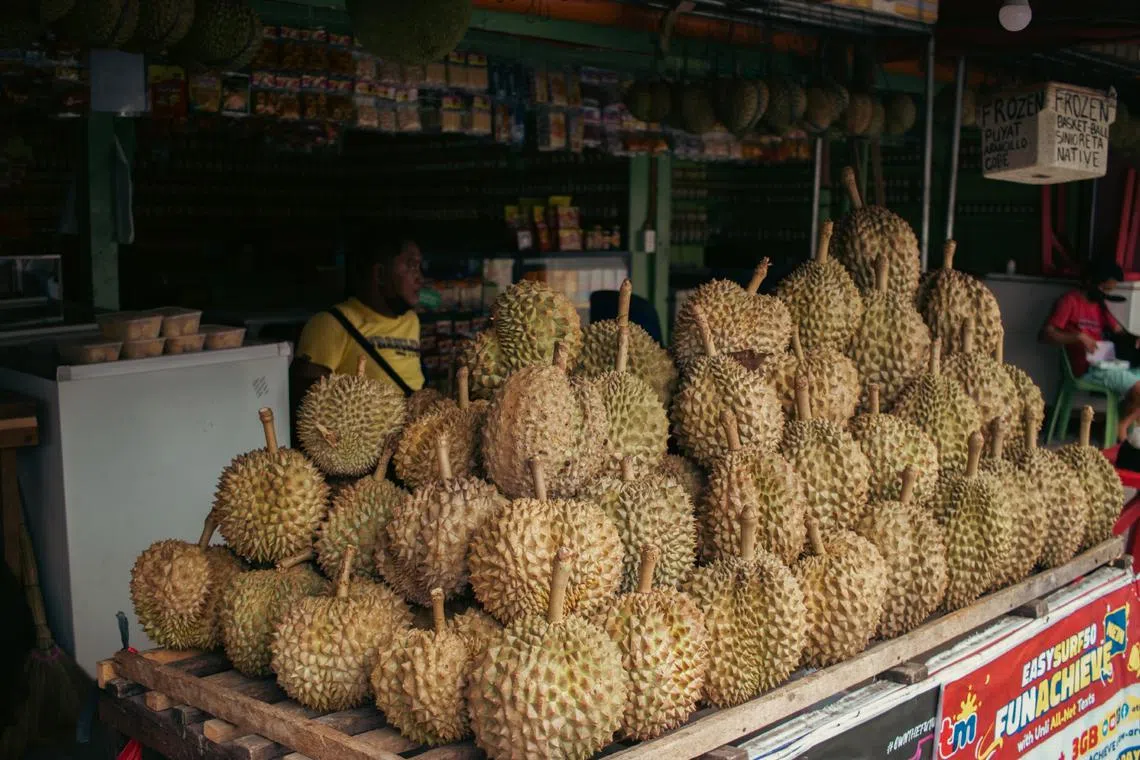Philippine durian growers eye more income as exports to China cleared
Sign up now: Get insights on Asia's fast-moving developments

Of all Filipino durian growers, durian production in Davao City accounts for about 80 per cent of the national total.
PHOTO: PEXELS
Follow topic:
MANILA – Mr Jomar Abdon, 29, was engaged in one of the most critical tasks in his durian processing facility: sorting durians by their variety. Standing in front of a pile of durians, he adeptly sorted out the higher-quality spikey fruits and prepared them for packaging.
Mr Abdon is happy that China cleared the exportation of Philippine durians to China on Wednesday, saying that the move could raise the income of the local growers of the tropical fruit in southern Mindanao’s Davao City, the Philippines’ third largest city.
His daily workload is likely to increase as a result.
“Our durians in Davao City are more delicious. For us, it is better to have our produce recognised by (China) and exported (there). It is an added income to farmers. More people will benefit from the proceeds,” he said.
As one of the most lucrative fruits that command a good price in the world’s largest consumer market, access to the enormous Chinese market is a bonanza for Filipino durian growers, especially those in Davao City, whose durian production accounts for about 80 per cent of the national total.
The local durian season in Davao City is from July to October every year. Compared to other renowned durian varieties, the popular varieties in Davao City, namely Puyat and D101, are more resistant to pests and more productive.
Mr Candelario Miculob, the former head of Davao City’s Durian Planters Association, told Xinhua that Davao City currently produces more than 50,000 tonnes of durian annually, with over 3,000 growers and more than five processing factories.
According to him, by estimating each household’s planting space based on 1 hectare allowing for 100 bearing trees, each family will have an additional income of about US$2,800 (S$3,750). After the opening up of the Chinese market, he said China will become the Philippines’ largest durian export destination.
“We are encouraging farmers to plant more. It will increase the farmers’ income, hopefully, improve their livelihood, and help reduce poverty. The two countries will improve their agricultural cooperation, and the Philippines will benefit from the increased agricultural output through the durian export,” he added.
According to the Philippine Department of Agriculture, around 9,696 direct jobs and 1,126 indirect jobs will be generated after Philippine durians are cleared to export to China. Direct jobs include additional workforce in farm and packing facilities, while indirect jobs include those in packaging, logistics and other services sectors.
In recent years, the Philippines and China have achieved fruitful agricultural cooperation, bringing tangible benefits to the people of the two countries.
With bananas, pineapples, mangos, young coconuts, and avocados from the Philippines being put on the table of the Chinese people, China has already established itself as one of the top importers of Philippine agricultural products.
This position is expected to grow stronger as China seeks to expand its Philippine fruit imports further to boost agricultural cooperation between the two countries.
Chinese Ambassador to the Philippines Huang Xilian said the first of the four major areas of cooperation identified by the leaders of the two countries, is agricultural cooperation. He said that although the tropical fruits in the Philippines are of high quality, the income level of the large population of fruit farmers is relatively low.
“Therefore, we hope some Philippine fruits that are popular with Chinese consumers can be exported to China. Durian is one of the best choices. We look forward to Philippine durians being placed on the dining table of the Chinese people soon,” he added. XINHUA

